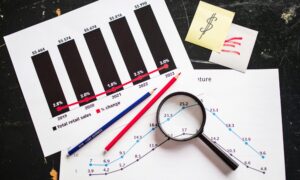What Is Data Analytics?
In simple terms, data analytics is the art of mining data sets, cleansing them, transforming them, and ultimately deriving significant insights that can help in different business processes. This connotes that the application of data analytics, as well as data analytics courses, has increased at various stages of business. Ranging from the domain of business management, business operations to the domain of critical decision making, the application of data analytics has become extremely significant. Driven by quantitative decision-making, businesses are making their way towards prospective expansion in various sectors.
In this article, we attempt to decode data analytics and explore the corresponding data handling challenges, solutions, and application prospects.
The upcoming data challenge
Given the rapid increase in various applications of data analytics, we expect a voluminous increase in data in the next few years. In addition to this, the rate of expansion of data also suggests that new sub-sectors would be populated by analytics in the coming times. There are a lot of traditional sectors like manufacturing, textiles, energy, mining, retail, logistics, and real estate that are relatively less affected by data analytics. However, this trend is slated to change in the times to come.
We may expect the erstwhile sectors that are relatively less influenced by data to shift operations in favor of analytics. This would signify a rapid increase in data sets that would in turn subject us to newer challenges. Most of the challenges would be related to the privacy and security of data. Another challenge that is likely to emerge would be the shortage of data analysts to handle the upcoming data waves. The challenge of security and privacy can be addressed by technological advancements in infrastructure. Similarly, the challenge of shortage of manpower can be addressed by reskilling and upskilling the existing workforce in data-driven technologies. One of the prospective ways to achieve this is to introduce data analyst courses and other re-orientation programs that can expose professionals to analytics skills at an early stage in their careers.
Preparing for the challenge: Viable solutions
The challenge of data analytics is looming large over the entire business sector. This can be overcome by following a multi-pronged approach. Significant advances need to be done at the level of people, processes, and platforms. This is popularly called the 3p approach to solve the problem.
At the level of people, the idea is to empower the workforce by means of vocational training. Early exposure to analytical skills can help professionals to develop a data-oriented temperament. Training in software development tools and techniques that help in analytics and related technologies is highly recommended.
When we look at bringing innovations in the level of platforms, we refer to the up-gradation of infrastructural capabilities. This can be achieved by exposing business professionals to data analytics platforms and other analytics projects.
Finally, the innovation at the level of processes signifies hands-on training as well as the change of skill development approach so that it becomes much more attractive and innovative. An innovative approach to data analytics is likely to attract a wide range of professionals to imbibe such skills.
An Insider’s View Of Data Analytics
The morphology of data analytics can be understood by subjecting various components of this process to deep analysis. The first important stage of data analytics is the collection of data. Traditionally, data has been collected through sources like questionnaires and surveys. Needless to mention, there is a limit upon the quantity of data that can be sourced by the above methodologies, tools, and techniques of data collection.
There has been a paradigm shift in the above approach to data collection. In the present times, millions of data entries need to be collected in real-time with very low latency. Moreover, some of the discrete samples need to be collected on the basis of pre-assigned parameters. The traditional methods of probability sampling are no longer relevant here. The focus has now shifted to advanced tools that are based on the tableau.
At the stage of data cleansing, the redundancy in the existing data sets is removed. The aim is to prepare the data sets for the stage of processing by mining the information that is relevant to the selected parameters. For instance, the demographic data of a particular place has been collected that is unstructured in nature. The aim of the survey is to source data sets that help in the investigation of the success of a medical intervention towards an epidemic. It is in this context that certain relevant parameters like symptoms of a particular disease, weight loss, and medical records would need to be retained and other aspects of the data sets would need to be discarded. This can be achieved with the process of feature extraction as well as dimensionality reduction.
After this stage, we can finally move on to exploratory data analysis that gives a detailed overview of the information that has been sought at the initial stage itself. The exploratory phase of information extraction can be subjected to advanced algorithms and selective models. Finally, we move on to the process of data visualization and communicate the finding of the entire project to the targeted audience. A supplementary stage of feedback mechanism can be introduced to make the model more effective and receptive to further inputs for future projects.
Application Prospects Of Data Analytics
Data analytics finds application in a large number of sectors and the most prominent among them are transportation and logistics. In the domain of transportation, data analytics helps in streamlining the traffic movement along very busy routes. Intelligent sensors are incorporated in traffic lights so that they function in a customized manner and reduce traffic congestion. Effective application of data analytics in the transportation sector also helps in reducing accidents. In the domain of logistics, analytics gives information about the best possible routes of packet delivery. It also helps in tracking the status of dispatched goods in real-time.
Some other prospective applications of data analytics are the sector of education and healthcare.
Data analytics in the education sector helps students at the individual level by creating a quantitative picture of their performance in a recent test. It also gives input to the students so that they can maximize their performance and compare their results to other students.
In the domain of healthcare, analytics helps in the examination of medical records and gives doctors and patients a common data platform to keep track of medical observation and investigation. One of the case studies of the application of data analytics in the healthcare sector has been the foundation of the national healthcare stack. The National Healthcare Stack is a centralized repository of medical records that are believed to have pathbreaking applications in the pursuit to cure diseases and formulate new drugs.
Concluding Remarks
The applications of data analytics are slated to increase in the time to come. This is especially important as the power of analytics is being harnessed by many emerging businesses and startups.
The increasing importance of data analytics in the age of the 4th Industrial Revolution signifies that adequate advances be made related to training, research, and development in this domain. It is only by making advanced preparations that we can reap the potential of analytics in its truest sense.



































